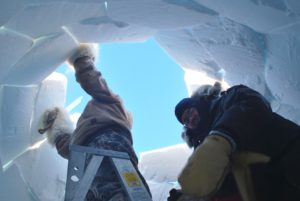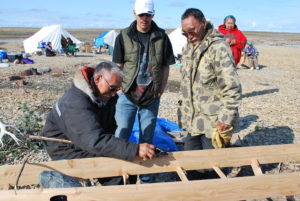This blog post was provided by the Pitquhirnikkut Ilihautiniq / Kitikmeot Heritage Society.
The Inuinnaqtun language—the foundation of Inuinnait culture—has less than 600 fluent speakers remaining. By most estimates, it is a language that will be extinct in two generations. The disappearance of Inuinnaqtun would be culturally devastating, disrupting the link to our past, to much of the knowledge held and accumulated by thousands of generations who came before us, and to our identity as Inuinnait.

The Inuinnaqtun language was declared as “definitely endangered” by UNESCO in 2015.
While the term Inuinnaqtun most often refers to the dialect of Inuktut spoken by Inuinnait, its true meaning is much more expansive: to speak, to create, to practice, to do, to think—to be—like an Inuinnaq (a human being). Our words, phrases and sentences hold deeply embedded meanings that describe and reinforce the long-honoured ways of being and relationships between all living things. These have been accumulated over millennia, passed on and sustained with each new generation until this cycle of transmission was interrupted.
The scars of colonization and the systemic oppression of Indigenous languages and cultures run deep. Intergenerational trauma causes ongoing language loss, shame and wellness issues. As we look to reconciliation, reclaiming and retaining our identity by passing on and learning our language and culture is at the heart of our healing. Inuinnaqtun is our link to our Elders and ancestors and the knowledge, worldview and cultural continuity that is our inheritance.
25 Years of Innovative Programs and Projects
At the Pitquhirnikkut Ilihautiniq/Kitikmeot Heritage Society (PI/KHS), we are a leader for culture and heritage in Nunavut. We are guided by an Inuinnaq Executive Director and Board, and are among the territory’s longest established heritage organizations. This year, we’re celebrating 25 years of leading innovative programs and projects.

We focus on the critical needs of Inuinnait—a distinct regional group of Inuit living in the Central Canadian Arctic. Our mission is to preserve and renew Inuinnait knowledge, language and culture for the benefit of all Inuit.
Stand With Pitquhirnikkut Ilihautiniq / Kitikmeot Heritage Society to Support Healing
In our 25th year, we are reconfirming our commitment to reawakening our language and culture. Many words and parts of our language are sleeping, disused and dormant following massive changes to our cultural communities over the past hundred years.

Guided by a five-year strategic plan and by Inikhaliuqatigiit, ‘the trail makers’, a group of Inuinnaqtun leaders from the four Inuinnaqtun-speaking communities, we are connecting the resources, technology and expertise critical to the survival of Inuinnaqtun and Inuinnait culture. Over the years, we have worked to document, preserve, transmit and celebrate our culture. Some highlights include: the creation of a Mentor-Apprentice Program, a long-standing Elder-in-Residence Program, and the development of a learning platform to house digital resources.
We are now embarking on a one-year campaign to raise $250,000 for the renewal of Inuinnaqtun in order to do the following:
Preserve Language Domains:We are now experiencing the passing of the last of the Elders who grew up on the land speaking fluent Inuinnaqtun. For these Elders the language was used to express every aspect of life—every area of knowledge. Working alongside Elders and fluent speakers, Inuinnait Linguists will record vocabulary and fluent speech in knowledge areas for which only our oldest generations have personal experience, creating a permanent record to ensure the fullest extent of the language is documented.
Awaken Inuinnaqtun in Silent Speakers: Language learning must also involve individual healing. Working with Indigenous partners, we will launch a new program to target Silent Speakers, who understand much of their mother language, but do not speak it due to intergenerational language trauma. We will work in partnership with local Elders, therapists and counsellors to deliver a pilot program to support Silent Speakers with the tools and coaching that will empower them to find their voice in Inuinnaqtun once again.
Expand Immersion Opportunities Across Inuinnait Communities: We will expand immersion opportunities across Inuinnait communities using pilot programs initiated in Cambridge Bay. language coaches in each community will act as satellites of the PI/KHS to 1) support local teams in the Inuinnaqtun Mentor-Apprentice Program (which pairs a fluent speaker and a learner for 300 hours of one-on-one immersion over one year), and 2) foster language nests (Inuinnaqtun-only spaces that uplift and support the development of learners through immersion in the language).
We’re all in for Inuinnaqtun. With support and engagement, we can empower Inuinnait to reconnect to our ancestors, our values, and the worldview that we steward.
To celebrate CanadaHelps’ 20th anniversary, Hope for Wildlife took part in a video series to highlight how charities touch all of our lives, every day. Watch how Hope for Wildlife is making a big impact in our film below. And watch the rest of the video series on our website.
Leave a Reply